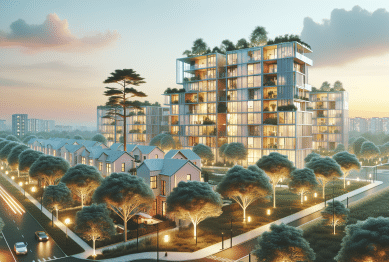Discover how targeted home renovations can boost property worth, attract more buyers, and create a living space you enjoy. This guide reveals which upgrades yield the most value and how smart remodeling choices can impact your home’s long-term appeal.
Why Renovations Matter in Real Estate
Renovating a home goes beyond simple aesthetics. Changes to kitchens, bathrooms, or energy systems can affect both comfort and the long-term value of a property. Strategic upgrades boost curb appeal and make homes more attractive to buyers in a crowded real estate market. Many homeowners seek advice on which improvements bring the greatest return. While every property is unique, common renovation choices can stand out with proper planning and execution. Attention to quality materials and professional installation pays off, elevating a home’s perceived and actual market worth.
Market trends continually evolve, and so do buyer preferences. For instance, energy-efficient improvements and smart home technologies are increasingly sought after in listings. Homeowners considering renovations should keep these trends in mind. Real estate experts suggest that even minor remodels, like updated fixtures or adding a fresh coat of paint, can improve a home’s competitiveness. The right updates can also result in a shorter selling timeline and more favorable offers. Modern design touches inspire confidence in potential buyers about the upkeep of the property.
Renovations also create opportunities for homeowners to enhance their daily living experience. A revamped kitchen, for example, supports home-cooked meals and family gatherings. A redesigned bathroom offers a touch of luxury and convenience. When evaluating possible upgrades, consider both the enjoyment they bring and their effect on resale value. Smart renovations blend utility, enjoyment, and market value seamlessly. By identifying what matters to both residents and buyers, it’s easier to prioritize projects for optimal results.
Identifying High-Value Home Upgrades
Understanding which renovations most affect property value is essential for homeowners. Kitchen remodels consistently rank among the most impactful, with new countertops, cabinets, and energy-efficient appliances ranking high on buyer wish lists. Bathrooms are another key focus; replacing old fixtures and tiles or adding a walk-in shower ignites buyer interest. Flooring upgrades, such as hardwood or sustainable materials, also support stronger property appraisals and interest. Research from industry experts highlights these upgrades as some of the most lucrative investments in real estate.
Energy-efficiency improvements offer more than lower utility bills; they often increase a home’s perceived value. Simple changes like installing double-pane windows or upgrading insulation can improve comfort while decreasing ongoing costs. Solar panels, programmable thermostats, and smart lighting add both convenience and future cost savings. Data shows buyers are increasingly interested in properties that promote sustainability and low operating costs. Energy-conscious investments can turn an ordinary property into a standout listing in eco-minded markets.
Curb appeal, though sometimes overlooked, provides a significant return. Landscaping enhancements and upgrades to the entryway, such as a new front door or fresh siding, can capture attention from the outset. First impressions are powerful, and buyers often make snap judgments as they approach a property. Investment in outdoor spaces, including patios and entertainment areas, continues to trend in recent years. A well-designed exterior invites exploration inside and can set a positive tone for showings and negotiations.
Budgeting and Financing Renovations
Effective renovation planning starts with a realistic budget. Assessing the current condition of the property and defining clear goals helps set priorities. Homeowners sometimes underestimate repair costs, but detailed cost estimates from contractors and consults with local real estate agents guide decision-making. Considering alternatives and phased renovations can prevent budget overruns. Some upgrades may qualify for financial incentives—such as rebates or tax credits—especially for energy efficiency improvements.
Financing options for renovations vary widely. Home equity loans or lines of credit are common choices, but personal loans and specialized renovation loans may suit certain situations better. Government-backed loan programs may also offer attractive rates and terms for eligible remodeling projects (Source: U.S. Department of Housing and Urban Development). Evaluating the interest rates and repayment terms protects homeowners from unexpected financial strain. Comparing loan products ensures alignment with both budget and project timeline.
Setting aside a contingency fund is a wise move. Industry professionals recommend allocating 10–20% of the renovation budget for unexpected expenses. This buffer accommodates surprises like structural issues or changes in material prices. Staying flexible throughout the process allows homeowners to adjust priorities as needed without compromising quality. Following a carefully structured financial plan ultimately leads to greater satisfaction with the renovation outcome.
Energy Efficiency and Smart Home Innovations
Energy efficiency is at the forefront of modern home renovations. Upgrades like better insulation, energy-efficient appliances, and LED lighting make homes more eco-conscious. These improvements reduce utility bills and appeal to environmentally-aware buyers. In some markets, properties with documented energy savings attract higher offers and sell faster compared to non-upgraded competitors. The rise of green building standards encourages homeowners to look into these valuable improvements for comfort and resale benefits.
Smart home technology has moved from luxury to expectation in many real estate markets. Devices such as smart thermostats, security cameras, and networked lighting systems offer remote access and automation. Tech-savvy buyers often consider these features essential. Integration of home networks and smart security may also increase perceived safety and convenience. The investment in smart tech can be modest compared to the lifestyle and selling advantages it brings. Home sellers note positive feedback from prospective buyers encountering thoughtful technology enhancements.
Renovations that merge eco-friendly upgrades with digital convenience provide a double benefit. For example, solar-powered smart irrigation systems minimize water use and utility costs while showcasing innovation. Documents certifying energy efficiency or smart system installations help during appraisals and negotiations, offering proof of value. Resources from the U.S. Department of Energy confirm that buyers increasingly search for these dual advantages during property hunts (https://www.energy.gov/energysaver/energy-saver).
How Location Impacts Renovation Value
Not all renovations provide the same return in every neighborhood. Local market trends, buyer demographics, and even climate drive which upgrades are most effective. In regions with hot housing demand, luxury kitchen or bath remodels might deliver strong returns, while in more modest markets, minor updates can have comparable impact. Researching local sales data gives insight into where investments will pay off most. Consulting with real estate professionals further tailors renovation strategies for specific neighborhoods.
Rental properties present different renovation considerations. In rental-heavy areas, durable materials and easy-to-maintain finishes often appeal to landlords and tenants alike. Upgrades that improve energy efficiency or reduce maintenance—such as vinyl flooring or heat-resistant roofing—are popular choices for investment properties. The National Multifamily Housing Council highlights how energy savings attract and retain renters by lowering their overall living costs (https://www.nmhc.org/research-insight).
Urban and suburban areas may prioritize different upgrades. Smart home features resonate more in fast-moving city markets, while spacious outdoor improvements might hold more value in suburban neighborhoods. Local ordinances and homeowner association rules can also influence which renovations are feasible. Staying informed on these regulations prevents unwanted setbacks, ensuring that upgrades maximize future value and align with community standards.
Avoiding Common Mistakes and Maximizing Impact
Poor planning and a lack of research often lead to disappointing renovation outcomes. Common mistakes include over-improving for the neighborhood, neglecting permits, or hiring unqualified contractors. Before beginning any project, consult with local experts, study successful remodels in the neighborhood, and check zoning ordinances. Transparent communication and clear project scopes prevent misunderstandings between homeowners and contractors, setting the stage for superior results.
Quality typically matters more than quantity. A few thoughtfully executed upgrades—like a modernized kitchen or improved insulation—impact property value more than dozens of minor, low-value changes. Focusing on highly visible and functional spaces drives the strongest return. Homeowners aiming to sell should assess what buyers in their market value most, prioritizing those features for maximum impact. Regular maintenance alongside larger renovations ensures the property shines during appraisals and showings.
Documentation is frequently overlooked. Save receipts, product warranties, contractor invoices, and before-and-after photos. These records support claims of quality and compliance when selling or refinancing. Disclosing comprehensive renovation details to potential buyers or appraisers builds trust and can influence negotiations. Resources from the National Association of Realtors offer guidance on the importance of thorough records and transparency in real estate transactions (https://www.nar.realtor).
References
1. National Association of Realtors. (n.d.). Remodeling Impact Report. Retrieved from https://www.nar.realtor/research-and-statistics/research-reports/remodeling-impact
2. U.S. Department of Housing and Urban Development. (n.d.). Home Improvements. Retrieved from https://www.hud.gov/program_offices/housing/sfh/title/repair
3. U.S. Department of Energy. (n.d.). Home Energy Saver. Retrieved from https://www.energy.gov/energysaver/energy-saver
4. National Multifamily Housing Council. (n.d.). Research & Insight. Retrieved from https://www.nmhc.org/research-insight
5. Harvard Joint Center for Housing Studies. (n.d.). Improving America’s Housing. Retrieved from https://www.jchs.harvard.edu/
6. Federal Trade Commission. (n.d.). Home Improvement and Repairs. Retrieved from https://consumer.ftc.gov/articles/home-improvement-repairs









